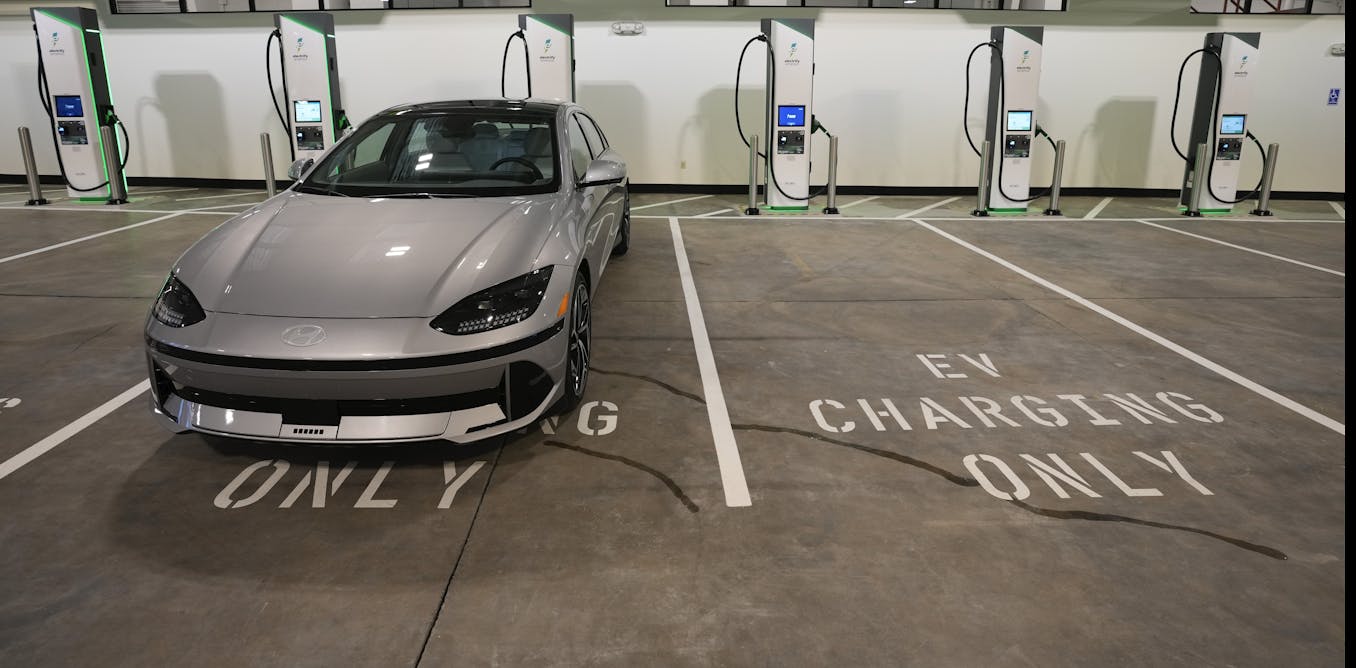EPA’s new auto emissions standard will speed the transition to cleaner cars, while also addressing consumer and industry concerns
The U.S. Environmental Protection Agency released strict new emissions limits on March 20, 2024, for cars built from 2027 through 2032. The final rule for Multi-Pollutant Emissions Standards caps a process that started almost a year earlier, when the Biden administration first proposed groundbreaking regulations that would essentially require automakers to make a substantial pivot toward electrification.The original proposal met significant pushback from carmakers and unions, who argued that the industry needed more time to switch from gas-powered cars to EVs. As a result, while the final target that this rule sets is very similar to the one that was initially proposed, the timetable in the final rule – especially in the earlier years – is relatively relaxed.
That means more carbon emissions in the short run. Politics is inevitably an important consideration in regulating major industries.
The new rule is projected to cut carbon dioxide emissions from passenger cars by nearly 50% in model year 2032 relative to existing standards. This requires a broad shift toward EVs, but automakers have many options for complying.
For example, they could emphasize producing battery-electric vehicles or more mixed fleets that include large shares of hybrids and plug-in hybrids, plus cleaner gas-powered cars. EPA projects that under the rule, in model years 2030-32, battery-electric vehicles may account for up to 56% of new cars, up from 7.6% in 2023.
As a researcher who studies the electric vehicle industry and adoption of EVs, I believe the new rule will nevertheless push electrification nationwide. There’s a lot of latent demand for this technology throughout the country, and this regulation will help bring that supply to broader populations. It also is likely to spur more installation of chargers and other supporting infrastructure.
Impacts on consumers
Traditionally, new fuel efficiency and emissions standards directly affect vehicle costs and often lead to higher prices at the dealership. However, the EPA projects that in the long term, driving electric vehicles, which cost less to fuel and maintain than gas-powered cars, will save owners US$6,000 on average over the life of a new car.
Moreover, EVs bring broader benefits, such as improved air quality and reduced greenhouse gas emissions, which benefit society as a whole.
Fossil fuel combustion generates many harmful pollutants, including fine particulates, which have been linked to a range of negative health effects. The EPA estimates that air pollution reductions triggered by the new rule will generate US$13 billion in annual health benefits.
Building confidence in batteries
One important feature of the new rule is that for the first time, the EPA has set forth explicit requirements for monitoring and ensuring the durability of EV batteries. This step recognizes that battery longevity is a pivotal factor in EVs’ value proposition and environmental impact.
The regulations delineate two primary benchmarks: The battery must retain at least 80% of its original capacity at five years or 62,000 miles and at least 70% after eight years or 100,000 miles. These requirements will help to standardize the wide variability in battery degradation between different vehicle models.
Importantly, the health of batteries must be tracked via a monitor in the car that measures what is known as the vehicle’s state of certified energy – the amount of battery capacity left at full charge after accounting for degradation – and displays it to the driver. EV owners will have constant information about the health of their battery, expressed as a percentage of what the battery had when it was brand new. This feature will be especially useful for people buying used EVs, since it will help them assess how much battery power the car still has at the time of purchase.
These and other battery durability and warranty requirements are likely to play a pivotal role in the EV market, influencing both manufacturers’ engineering choices and consumers’ purchasing decisions. By setting clear standards, the EPA is driving the industry toward more robust and reliable battery technologies, which could enhance the overall attractiveness of EVs and accelerate their market penetration.
When is a plug-in running on electricity?
Another item in the new regulations shows how the EPA has attempted to address manufacturers’ concerns. Since plug-in hybrids, or PHEVs, can run on either electricity or gasoline, regulators need some basis for determining how often they rely on one versus the other. The number that experts use in these situations, called the utility factor, is a calculation of what fraction of the time a PHEV drives on electricity.
Many researchers had argued that the EPA had overestimated the utility factor and warned that inflating the extent to which PHEVs operated on electric power could lead to regulations that put too much priority on these vehicles. Under the newly finalized regulations, the agency has adjusted the calculation to reflect a better understanding of how these vehicles operate in the real world.
For example, the adjustment in the utility factor for a model like the Prius Prime, with a 48-mile electric range, reduces the assumption of electric travel from the previous 65%-70% to about 55%. Similarly, for the Jeep Wrangler 4xe, with a 21-mile range, the utility factor is adjusted from around 40% to 30%.
These changes provide a more accurate reflection of PHEVs’ contribution to reducing emissions, which helps ensure that the regulatory framework aligns better with actual usage patterns. And by modifying the utility factor, the EPA may nudge manufacturers toward prioritizing more efficient PHEVs or shifting their focus toward fully electric vehicles.
A clear signal to carmakers
Changing auto efficiency standards has traditionally meant making incremental improvements in vehicle technologies, such as increases in engine efficiency. This new rule is much more aggressive and has a clear goal of driving a major shift toward EVs and other clean car types.These standards can help companies set goals for the future by providing clear targets. Failing to meet EPA rules can incur tough penalties.
In my view, these standards are an important step in the right direction to achieve U.S. climate goals, and they will serve as a stick that complements the monetary carrots funded by the Inflation Reduction Act, which authorized tax credits and subsidies for EVs and charging stations. The new rule may not be a perfect policy from a pure climate perspective, but given automakers’ concerns and the political sensitivity of this issue, I believe it hits the target.

EPA’s new auto emissions standard will speed the transition to cleaner cars, while also addressing consumer and industry concerns
The new rule isn’t a mandate for electric vehicles, but it will sharply increase their market share over the coming decade.
 theconversation.com
theconversation.com

